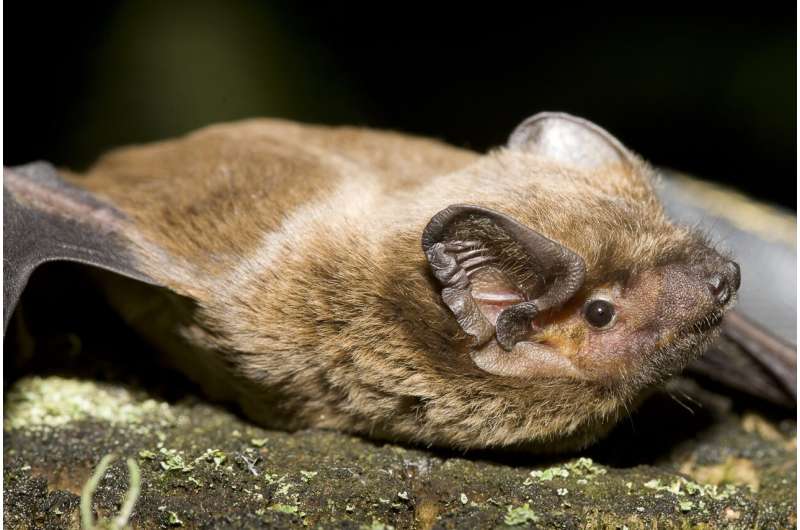This article has been reviewed according to Science X's editorial process and policies. Editors have highlighted the following attributes while ensuring the content's credibility:
fact-checked
peer-reviewed publication
proofread
DNA analysis of bat droppings shows astonishingly high number of insect species

Adequate food supply is a fundamental need and requirement for survival. To protect a species, it is often very helpful to know what that species prefers and frequently consumes. Through the analysis of DNA traces in the droppings of a Leisler's bat colony, researchers at LIB (Leibniz Institute for the Analysis of Biodiversity Change) have now identified an astonishingly high number—more than 350—different insect species that were consumed by the bats.
The findings are published in the Biodiversity Data Journal.
Especially for small animal species and those that are nocturnal, it can be extremely difficult to determine what they feed on. Identifying small prey insects or their remains is also rarely possible down to the exact species or family. In the case of the studied bat species, there is the additional challenge that it is a forest bat species that needs to be located first. "Following bats equipped with radio transmitters in the forest at night is quite special," says Martin Koch, co-initiator of the study.
Fortunately—but also complicating matters—there are about 13 different bat species living in the investigated area near Bonn, in the forests of the Natura 2000 area "Waldreservat Kottenforst." Initially, as part of an EU Life+ project, roosts—the trees where the bats live—of the Leisler's bats were identified, from which the study's starting material was then obtained. This was done using a specially developed "guano trap." The trap consists of approximately 2.2 square meters of mosquito netting stretched rectangularly.
It was installed about 3 meters high on the tree trunk, below the entrance to the roosting cavity at about 9 meters high. During the so-called "twilight swarming" after the nightly insect hunt, the bats return to the roosting cavity and initially circle the tree. They frequently perch briefly next to the cavity entrance and stick a small guano pellet to the trunk. Regularly, pellets fall and land in the mosquito netting under the cavity entrance. This bat guano was collected, fixed, and further processed in the laboratory.
"It's fascinating how much DNA you can extract from a small amount of droppings and how much information we can draw from the DNA: From which bat species does the droppings come, and what has the bat eaten?" explains Dr. Kathrin Langen, TA Metabarcoding.
Using the DNA contained in the droppings, the researchers were able to determine nine samples from nine different nights when only the target species swarmed around the roosting tree. On six other nights, other bats and a species of mouse were also active around the roosting tree.
From the nine samples containing only the guano of the evening bat, an astonishingly rich menu was then reconstructed: The group consumed at least 126 different species of moths, 86 different species of flies and mosquitoes, 48 species of beetles, and a few dozen other various species of bugs, mayflies, caddisflies, and lacewings. Occasionally, spiders, harvestmen, lice, and other small animals were also consumed.
From the results, the team was able to deduce which of the three molecular genetic markers used worked best and provided the most species detections, a total of 358. "It's incredibly satisfying to see what species lists come out at the end of all the lab work and bioinformatics," says Dr. Sarah Bourlat, Head of the Metabarcoding Section at LIB, Bonn.
However, the temporal course of the composition of the consumed insects was also interesting to observe: from late March to late June, the number of species in the guano steadily increases, only to decrease again by mid-August. This aligns very well with the activity patterns of certain insect groups.
The beech moth was the most frequently consumed butterfly, and a mayfly known as the transient virgin or "Uferaas," was the most frequently consumed mayfly. The author team has listed the most important ecological parameters for the 18 key prey species in the study to contribute to better protecting the Leisler's bat and the habitats needed by its prey insects.
More information: Sarah Bourlat et al, Metabarcoding dietary analysis in the insectivorous bat Nyctalus leisleri and implications for conservation, Biodiversity Data Journal (2023). DOI: 10.3897/BDJ.11.e111146
Journal information: Biodiversity Data Journal
Provided by Leibniz-Institut zur Analyse des Biodiversitätswandels

















